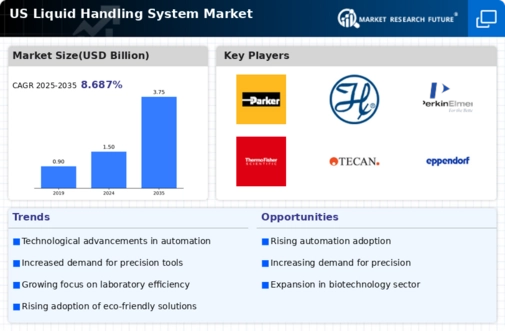Expansion of Biotechnology Sector
The liquid handling-system market is poised for growth due to the expansion of the biotechnology sector. As biotechnological applications continue to evolve, the demand for precise and reliable liquid handling systems is increasing. The biotechnology industry, which encompasses areas such as genetic engineering, molecular biology, and biomanufacturing, relies heavily on liquid handling technologies for various applications, including sample preparation and assay development. The market is projected to grow at a CAGR of approximately 9% as biopharmaceutical companies invest in advanced liquid handling solutions to enhance their research capabilities. Furthermore, the rise of personalized medicine and biologics is driving the need for innovative liquid handling systems that can accommodate complex workflows. This trend highlights the critical role of the liquid handling-system market in supporting the biotechnology sector's growth and innovation.
Increased Focus on Laboratory Efficiency
The liquid handling-system market is benefiting from an increased focus on laboratory efficiency and productivity. Laboratories are under constant pressure to deliver results faster while maintaining high standards of quality. As a result, there is a growing trend towards the automation of liquid handling processes, which can significantly reduce manual labor and minimize errors. Recent studies indicate that automated liquid handling systems can improve throughput by up to 50%, making them an attractive investment for laboratories aiming to enhance their operational efficiency. Additionally, the integration of liquid handling systems with laboratory information management systems (LIMS) is becoming more common, facilitating better data management and workflow optimization. This emphasis on efficiency is likely to propel the liquid handling-system market forward, as organizations seek to streamline their operations and reduce costs.
Rising Demand in Pharmaceutical Research
The liquid handling-system market is significantly influenced by the increasing demand for pharmaceutical research and development. As the pharmaceutical industry continues to expand, the need for efficient liquid handling systems becomes paramount. The market is expected to witness a growth rate of around 10% annually, fueled by the rising number of drug discovery projects and clinical trials. Liquid handling systems play a critical role in high-throughput screening, sample preparation, and compound management, which are essential processes in drug development. Moreover, regulatory requirements for accuracy and reproducibility in laboratory results further drive the adoption of sophisticated liquid handling technologies. This growing emphasis on precision in pharmaceutical research underscores the importance of the liquid handling-system market in supporting the industry's evolving needs.
Regulatory Compliance and Quality Assurance
The liquid handling-system market is significantly impacted by the stringent regulatory compliance and quality assurance requirements in various industries. Laboratories are mandated to adhere to strict guidelines to ensure the accuracy and reliability of their results. This has led to an increased demand for liquid handling systems that offer enhanced precision and traceability. The market is expected to grow as organizations invest in technologies that facilitate compliance with regulations set forth by agencies such as the FDA and EPA. Moreover, the emphasis on quality assurance in laboratory processes is driving the adoption of automated liquid handling systems, which can provide consistent results and reduce variability. This focus on regulatory compliance and quality assurance is likely to sustain the growth of the liquid handling-system market, as organizations prioritize reliability and accuracy in their operations.
Technological Advancements in Liquid Handling
The liquid handling-system market is experiencing a surge due to rapid technological advancements. Innovations in automation and precision engineering are enhancing the efficiency and accuracy of liquid handling systems. For instance, the integration of advanced robotics and artificial intelligence is streamlining laboratory processes, reducing human error, and increasing throughput. According to recent data, the market is projected to grow at a CAGR of approximately 8% over the next five years, driven by these technological improvements. Furthermore, the adoption of smart liquid handling systems is becoming prevalent, allowing for real-time monitoring and data analysis, which is crucial for research and development in various sectors, including pharmaceuticals and biotechnology. This trend indicates a robust future for the liquid handling-system market, as organizations seek to optimize their operations and improve productivity.




















Leave a Comment